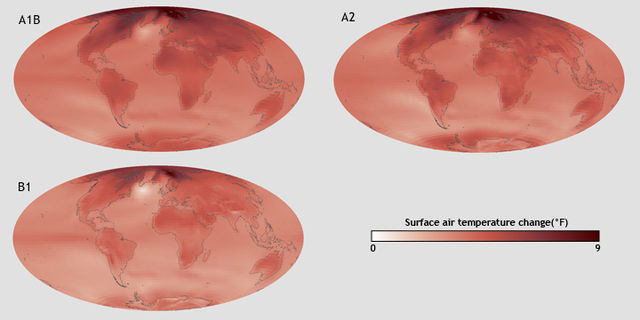 |
This is a file from the Wikimedia Commons. Information from its description page there is shown below.
Commons is a freely licensed media file repository. You can help.
|
Summary
| Description |
English: The following description is based on the cited public-domain source (Gardiner et al, 2012): These maps show the average of a set of climate model experiments projecting changes in surface temperature for the period 2050-2059, relative to the period from 1971-1999. There are three different maps. Each map shows projected temperatures for a different scenario of future greenhouse gas emissions. The top left map corresponds with IPCC emissions scenario A1B; the top right map IPCC emissions scenario A2; and the bottom left map IPCC emissions scenario B1. These emissions scenarios are described in the following paragraphs. All models project some warming for all regions, with land areas warming more than oceans.
"The net impacts of [...] human actions and choices on future greenhouse gas concentrations are fed into models as different “scenarios.” For example, [IPCC Scenario B1] assumes that humans worldwide will make more sustainable development choices by using a greater range of, and more efficient, technologies for producing energy. In this scenario, carbon emissions are projected to increase from today’s rate of about 9 billion metric tons per year to about 12 billion tons per year in 2040, and then gradually decline again to 1990 levels—5 billion tons per year—by 2100.
[IPCC Scenario A2] assumes humans will continue to accelerate the rate at which we emit carbon dioxide. This is consistent with a global economy that continues to rely mainly on coal, oil, and natural gas to meet energy demands. In this scenario, our carbon emission increases steadily from today’s rate of about 9 billion tons per year to about 28 billion tons per year in 2100. [IPCC Scenario A1b] assumes humans will roughly balance their use of fossil fuels with other, non-carbon emitting sources of energy.
Because temperature projections depend on the choices people make in the future, climate scientists can’t say which one of the scenarios is more likely to come to pass by the end of the century. These scenarios are estimates, and greenhouse gas concentrations may grow at rates that are higher or lower than the scenarios shown in the graph. If future carbon dioxide emissions follow the same trajectory as they have over the last decade, increasing at a rate of more than 3 percent per year, carbon dioxide levels in the atmosphere would exceed [the IPCC A2 scenario] by the end of this century, if not before."
Projected changes in global mean temperature over the 21st century for these three emissions scenarios can be accessed at: File:Projected global warming over the 21st century using three SRES greenhouse gas emissions scenarios. Data from CMIP3 (2007).png.
|
| Date |
6 March 2012 |
| Source |
ClimateWatch Magazine » Global Temperature Projections. NOAA Climate Portal. |
| Author |
Ned Gardiner, Hunter Allen, and Jay Hnilo |
Permission
( Reusing this file) |
Privacy Policy, Disclaimer, and Copyright Notice: ngdc.noaa.gov: "As required by 17 U.S.C. 403, third parties producing copyrighted works consisting predominantly of the material produced by U.S. government agencies must provide notice with such work(s) identifying the U.S. Government material incorporated and stating that such material is not subject to copyright protection within the United States. The information on government web pages is in the public domain and not subject to copyright protection within the United States unless specifically annotated otherwise (copyright may be held elsewhere). Foreign copyrights may apply."
|
Licensing
| Public domainPublic domainfalsefalse |
 |
This image is in the public domain because it contains materials that originally came from the U.S. National Oceanic and Atmospheric Administration, taken or made as part of an employee's official duties.
|
|
File usage
The following pages on Schools Wikipedia link to this image (list may be incomplete):
This file contains additional information, probably added from the digital camera or scanner used to create or digitize it. If the file has been modified from its original state, some details may not fully reflect the modified file.
This selection has made Wikipedia available to all children. SOS Children's Villages believes that a decent childhood is essential to a happy, healthy. Our community work brings families new opportunities through education, healthcare and all manner of support. Why not try to learn more about child sponsorship?




